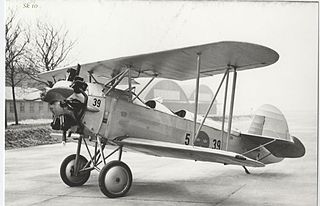Related Research Articles
The Gerhard Fieseler Werke (GFW) in Kassel was a German aircraft manufacturer of the 1930s and 1940s. The company is remembered mostly for its military aircraft built for the Luftwaffe during the Second World War.

The Fieseler F2 Tiger was a German single-seat aerobatic biplane which was flown to victory in the 1934 World Aerobatics Competition (WAC) by its designer/builder Gerhard Fieseler.

Gerhard Fieseler was a German World War I flying ace, aerobatics champion, and aircraft designer and manufacturer.

The Flight Regiment 19, also known as the Swedish Voluntary Air Force or F 19 was a Finnish Air Force unit, manned by Swedish volunteers, which operated from Kemi in northern Finland for the last 62 days of the Winter War. The aircraft also came from the Swedish Air Force inventory. Its designation number was taken from the Swedish Air Force which had 18 flying regiments at the time. The designation F 19 has not been used in Sweden. When new regiments were formed they were named F 20, F 21 and F 22.

The history of AEKKEA, an aircraft maker based in Greece, is connected with the history of a talented German aircraft designer, Antonius Raab.
The AEKKEA-RAAB R-29 was a Greek single-seat parasol monoplane trainer and/or light fighter developed by Antonius Raab, a German aircraft designer, with his Greek partners and was the sole Raab aircraft to be developed in Greece.
AB Svenska Järnvägsverkstädernas Aeroplanavdelning, commonly shortened to ASJA, was a Swedish aircraft manufacturing company.

The LVG C.VI was a German two-seat reconnaissance and artillery spotting aircraft used during World War I.

Raab-Katzenstein RK-26 Tigerschwalbe, also known as the Fieseler F 1 Tigerschwalbe, was a German twin-seat biplane trainer aircraft designed by Gerhard Fieseler by the end of the 1920s.

The Fieseler Fi 168 was a projected German ground attack aircraft designed in 1938 by Frederik Kassel, who created the aircraft after a request from the Technisches Amt of the RLM Reichsluftfahrtministerium -.
Waldau Army Airfield is a former military airfield, located 4.0 km south of Kassel in Hesse, Germany.

The Volksflugzeug was a grand Nazi-era scheme for the mass-production of a small and simple airplane in the 1930s. It was one of the attempts of the Nazi regime to use consumer technologies as a propaganda tool. Unlike the Volkswagen car, the showpiece of the Nazis’ attempt to appear to work for the good of the average German, as well as the less-known Volksempfänger radio, the Volkskühlschrank refrigerator and the Volksgasmaske gas mask, the Volksflugzeug project was contemplated but never fully realized.
Luise Hoffmann was a German aviator. She was the first woman test pilot in Germany, and possibly in Europe.

The Raab-Katzenstein KL.1 Schwalbe (Swallow) was a German two-seat biplane produced in the 1920s. About fifty were built and the type became well known as an aerobatic aircraft, performing at many displays in the hands of pilots like Gerhard Fieseler.

The Raab-Katzenstein RK.9 Grasmücke (Hedge-sparrow) was a 1920s German two-seat touring, advertising and training biplane. It was one of many designs from several countries aiming to provide low cost flying and was quite successful, with about twenty built.

The Raab-Katzenstein RK.25 was a two-seat, low wing cantilever monoplane aircraft designed and built in Germany in the 1920s for fast touring. Three were built and one had some success in a 1928 international contest. Another was later re-engined and provided with cabin accommodation.

The Fieseler F 3 Wespe ("Wasp") was a German aircraft developed in the early 1930s by Gerhard Fieseler. Little history of the aircraft remains due in part to destruction of records and documents during World War II.
References
- 1 2 3 "Raab-Katzenstein Flugzeugwerk GmbH" . Retrieved 2 August 2017.